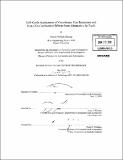Life cycle assessment of greenhouse gas emissions and non-CO₂ combustion effects from alternative jet fuels
Author(s)
Stratton, Russell William
DownloadFull printable version (21.85Mb)
Other Contributors
Massachusetts Institute of Technology. Dept. of Aeronautics and Astronautics.
Advisor
James I. Hileman.
Terms of use
Metadata
Show full item recordAbstract
The long-term viability and success of a transportation fuel depends on both economic and environmental sustainability. This thesis focuses specifically on assessing the life cycle greenhouse gas (GHG) emissions and non-CO 2 combustion effects from conventional jet fuel and synthetic paraffinic kerosene (SPK). The research expands upon the work of Wong (2008) by examining Fischer-Tropsch jet fuel from coal and biomass, and hydroprocessed renewable jet (HRJ) fuel from rapeseed, jatropha, algae and salicornia. Each fuel option is a "drop-in" alternative in that they are compatible with existing aviation infrastructure. Using a modified version of the APMT climate impacts module, the additional climate forcing from non-CO 2 combustion effects is combined with the fuel life cycle GHG inventories. Life cycle GHG emissions are only one of many aspects that must be considered when evaluating the feasibility and sustainability of an alternative fuel option. While cost and fresh water availability are important constraints, fuel yield and land requirements for select biomass-based fuel pathways are quantified. This is most important for feedstocks requiring cropland for cultivation. For example, current global production of soy, palm and rapeseed oil translate to only 34%, 43% and 18% of US jet fuel demand, respectively; hence, even small fractions of the petroleum industry translate to massive production scales in absolute terms. By comparison, HRJ from algal oil can yield more than an order of magnitude higher fuel production per hectare of land. Few biofuels were identified with zero life cycle GHG emissions. This contradicts previous studies and likely results from avoiding the displacement method to allocate emissions. Considerable inter and intra fuel option variability was found in life cycle GHG emissions; land use change contributed much to the variability of many pathways. The range in life cycle GHG emissions of all fuel options examined ranged from 0 to 9.1 times those of conventional jet fuel. The uncertainty in treating non-CO 2 combustion effects was found to have a larger influence on the life cycle emissions of each fuel option than the variability of the life cycle GHG inventories; however, including non-CO 2 combustion effects reduced the overall range in emissions of all fuel options considered to only 0 to 4.7 times those of conventional jet fuel. Hence, the inclusion of non-CO 2 effects in the fuel life cycle increases the absolute uncertainty of each fuel option but reduces the overall variability in the life cycle emissions of alternative fuels relative to conventional jet fuel.
Description
Thesis (S.M.)--Massachusetts Institute of Technology, Dept. of Aeronautics and Astronautics, 2010. Cataloged from PDF version of thesis. Includes bibliographical references (p. 135-144).
Date issued
2010Department
Massachusetts Institute of Technology. Department of Aeronautics and AstronauticsPublisher
Massachusetts Institute of Technology
Keywords
Aeronautics and Astronautics.